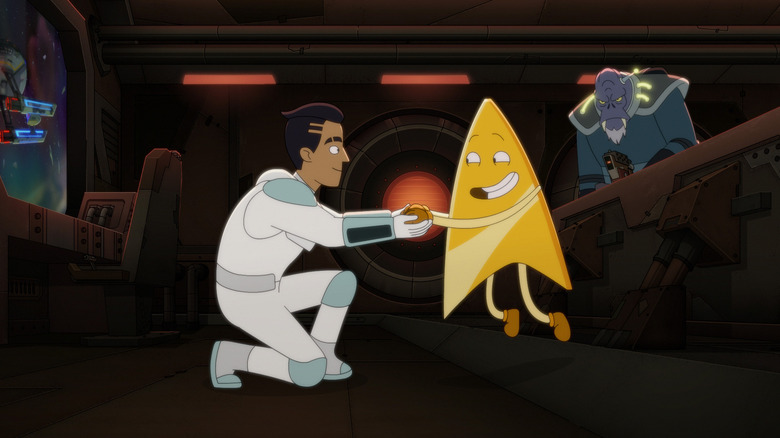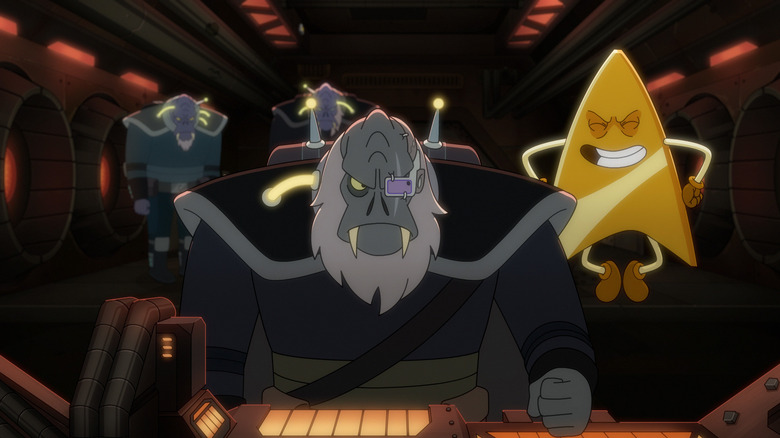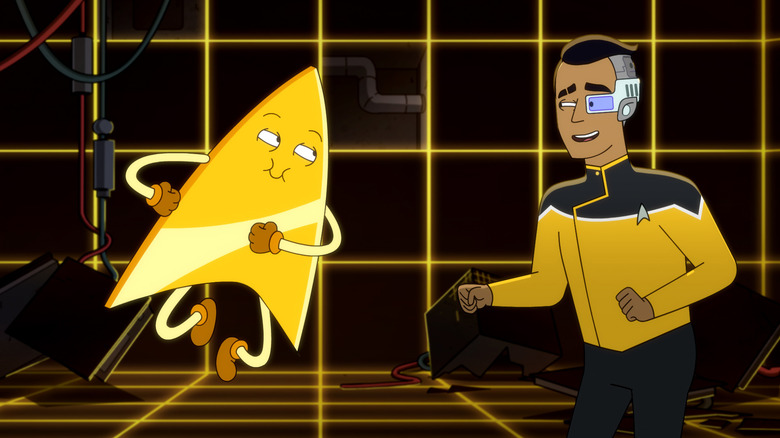Lower Decks Just Created The Most Powerful Villain In Star Trek History
Warning: This post contains spoilers for season 4, episode 7 of "Star Trek: Lower Decks."
The newest episode of "Star Trek: Lower Decks," called "A Few Badgeys More," sees the return of three of the show's more notorious villains, all of them sentient computers or artificial life forms. The first villain is Peanut Hamper (Kether Donohue), a small, floating robotic exocomp who was once a Starfleet officer but who betrayed her rank and discovered deceit and villainy were a better way to get the power she wanted. The second is AGIMUS (Jeffrey Combs), a malevolent computer whose programming broke and led him toward the path of world domination. Both Peanut Hamper and AGIMUS are currently incarcerated in a Starfleet rehabilitation prison designed specially for evil machines that go rogue. Evidently, villainous computers are common enough to warrant such a facility.
The third villain is, as the title notes, Badgey (Jack McBrayer), an anthropomorphic Starfleet insignia created by Lieutenant Rutherford (Eugene Cordero) in the episode "Terminal Provocations" (September 10, 2020) to serve as an instructional holographic program on the U.S.S. Cerritos' holodeck. Thanks to a malfunction, however, Badgey became murderous ... and self-aware. Badgey seemed hellbent on destroying his "father," and Rutherford manages to take Badget offline. In the season one finale, "No Small Parts" (October 8, 2020), however, Rutherford reluctantly brought Badgey back online to aid the Cerritos in a battle operation. After some complicated computer virus shenanigans on several ships, Badgey ended up implanted in Rutherford's cybernetic implants ... and then ripped out of the officer's head by his own security chief.
At the start of "A Few Badgeys More," Rutherford's old head implant is salvaged by a passing alien species, and Badgey re-activates himself to go on a mission of revenge, essentially assimilating sentient beings like the Borg. The true extent of Badgey's power is finally explored.
Badgey's power may be infinite.
Badgey and the Infinite
By the end of the episode, Badgey's intelligence becomes unbound by the confines of the computer servers holding his electronic consciousness, as he manages to upload himself into a subspace relay. His mind stretches into every single computer in the quadrant, allowing him access to the near infinite knowledge contained therein. He can explode every at once, kill anyone he thinks of. His thoughts become folded into the very fabric of space-time. In a terrifying shot, Badgey's pointed delta-shaped head emerges, thousands of lightyears across, from the heart of the Milky Way galaxy. Badgey transforms himself into a god.
Luckily, Badgey's newfound ability to perceive all of reality at once — to see the birth of time and the ultimate death of the universe, to perceive the subtle divine strands that connect all conscious beings — are beautiful to him. The instant Badgey becomes a wrathful deity, he also becomes benevolent.
Very occasionally, "Star Trek" will encounter characters who scrape up against the infinite. There is a raft of gods throughout the franchise that have declared themselves to be infinitely powerful, or at least powerful enough to destroy the galaxy with a thought. One might immediately think of Trelane (William Campbell), the impish war-mongering child god from the "Original Series" episode "The Squire of Gothos" (January 12, 1967), of Charlie X from "Charlie" (September 15, 1966), or of Q (John De Lancie) a recurring trickster god from "Star Trek: The Next Generation." The closest analog to Badgey is probably Lieutenant Commander Gary Mitchell (Gary Lockwood) from the "TOS" episode "Where No Man Has Gone Before" (September 22, 1966), who begins life as a human but ultimately evolves into an ambitious, destructive deity.
Badgey, it seems, might be more powerful than them all.
The Delta is the Alpha and Omega
Of course, measuring characters in terms of "most powerful" is an arbitrary and meaningless distinction in "Star Trek." Power in the franchise's lore is not measured by one's ability to cause destruction — that's the purview of comic book superheroes — but by the strength of one's character. One may have the ability to create or destroy entire universes, but "Star Trek" is a humanist show that more highly values integrity, creativity, moral righteousness, and one's devotion to the betterment of sentient life. This is why Starfleet captains like Kirk (William Shatner) or Picard (Patrick Stewart) roll their eyes when they encounter a god. Infinite power is unimpressive and not at all threatening. Benevolence, intelligence, and understanding are more important to Starfleet.
In this regard, however, Badgey may also prove to be the most powerful character in "Star Trek." Unlike Q, Trelane, Charlie X, or Lieutenant Commander Mitchell, Badgey seems to stand in awe of his own infinite might. He reaches into the infinite and finds not selfish desires and access to self-aggrandizement, but humility. The temptation to ascend — to gain ultimate enlightenment — becomes irresistible.
Of course, the joke of "Lower Decks" is that the main characters can stand by and witness the most extraordinary acts of semi-divine machine consciousness, and then still have to clock in for work the next morning. Rutherford may have unwittingly, through an extended set of circumstances, created the world's most powerful entity, but he seems merely gently chuffed that the universe wasn't destroyed. None of them will require a counselor — or a clergyman — anytime soon. The divine strands of the infinite cosmos? Old hat.
New episodes of "Star Trek: Lower Decks" drop Thursdays on Paramount+.


